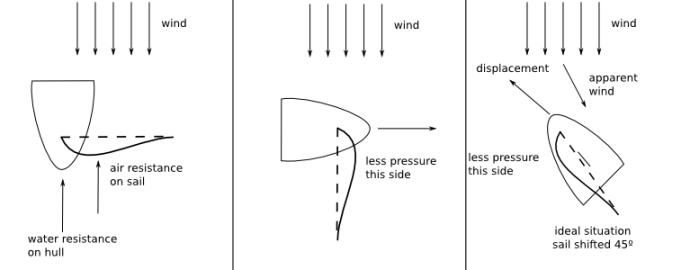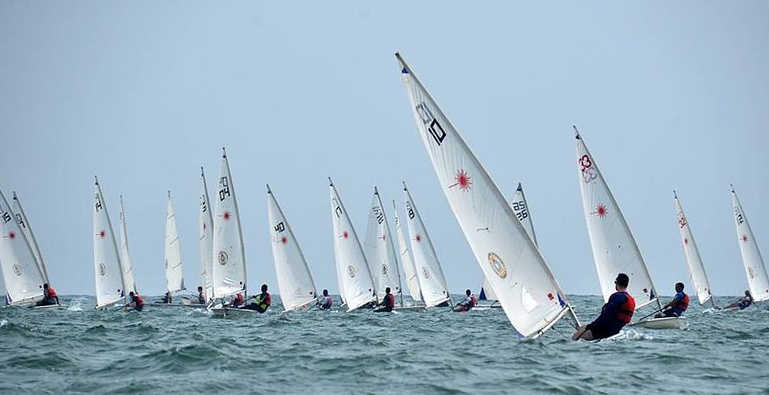2016, year of Olympic Games. I will write some posts about how works some sports. But I will not talk about rules. I will talk about how things work physically. Start talking about sailing, sport that I am AVRM (Assistant Venue Results Manager).
It’s heavy, but does not sink
How a ship does not sink in the water? Imagine getting on the crowded subway or elevator. You push people and they push you back. This is what happens with water. When you push an object into the water the water push it out. The name of that force that the water does is buoyancy and that force is equal to the weight of the amount of water displaced. Thus we have three situations:
- the object sinks: the buoyancy of the water is smaller than the object weight (E <P);
- the object stays in same place: the buoyancy of water is equal to the weight of the object (E = P);
- the object float: the buoyancy of the water is larger than the object weight (E> D).
Do the experience
Fill a bucket, the kitchen sink or the bathroom sink with water. Take a plastic pot and place it over the water. It will float, right?
Now try to sink the pot pushing down from inside. You will feel a resistance of the water. This resistance is water “pushing out” the pot.
Mark the height to where you dipped the pot. Fill the pot with water to this mark. The weight of the pot with water is equal to the force that the water was doing to raise the pot.
But a boat is much heavier than a little pot !!! Yea, and also much bigger and displaces much more water. Water enough to the buoyancy be greater than the weight of the boat. Just keep in mind that 1 liter of water weighs 1 kg and occupies the space of a cube measuring 10 cm on each side. It seems little but, trust, is not.

The brazilian site, Manual do Mundo, build a paperboard boat that does not sink (in portuguese). Doing quick and easy calculations based on the template available in pdf, this boat is capable of supporting 500 kilograms of weight, i.e. half a ton! (These calculations are in the end of this post, if you want to see)
Sailing on and on and north…
In competitions, the starting line of the boats and the route is defined as the wind direction. The boats always start the race going against the wind. But how can go upwind without engine? True, they can not. The sailing boats are only able to face the wind doing zigzag, called “tack”.
The sail works as the wing of an airplane. The side of the sail that is downwind has a lower pressure than the side that is upwind. This pushes the boat practically in a direction perpendicular to the sail position. If it was only that situation the boat would continue going in the near direction where the wind blows. The keel do a force to the other side that makes the boat move forward. See the figure below.
… Faster than wind
The sail can assume three different positions in relation to the wind:
- perpendicular to the wind: in this position the boat can reach maximum to wind speed, since we have air resistance on the sail and water resistance in the boat hull. The keel is not necessary only in this case.
- almost parallel to the wind: almost because if the sail stays completely aligned with the wind, it will “flag” and the boat will be stoped. A slight inclination to the wind direction will do the boat ride, but very slow.
- between the two positions: here is when the boat moves. The ideal angle is when the sail is 45 degrees to the wind. At this angle the boat reaches the higher speeds and might even go faster than the wind speed.
But how faster than the wind? In the case where the sail is inclined with respect to the wind, pressure on the “outside” of the sail is always less than in the pressure “inside”. So the air resistance is very small and the boat goes faster and faster. You can reach 20-30% speed faster than the wind. Iceboats, boats that sails on ice, can reach speeds of 150 km/h with winds of just 50 km/h, since the ice offers almost no resistance to movement.
The sailor also feels a “tailwind” which is the combination of the true wind direction and direction of travel.

And the boat does not turn?
Yes, it turns if not taken care. The wind pushes the sail and the boat can capsize, but the keel has a lead bulb that makes a balance. Also, the sailor serves as a counterweight to avoid the boat turn. That’s the reason in regattas you always see the sailor on the edge of the boat and sometimes completely out of it!
Sailing in numbers
- 116 years in the Olympic Games, since 1900 in Paris. Would debut in 1896, but won’t happened due the weather conditions.
- 10 different classes in 2016: RS:X Men, RS:X Women, Laser Men, Laser Radial Women, Finn Men, 470 Men’s double, 470 Women’s double, 49er Men double, 49er FX Women’s double, Nacra 17 (mixed double).
- until 380 athletes competing in 2016.
- Brazil has 17 Olympic medals in sailing. 6 golds.
- Robert Scheidt was 10 times world champion in the Laser class. He has 5 Olympic medals and 5 Pans.
- Torben Grael has 5 Olympic medals and 3 Pans.
- Claudio Biekarck is the Pan record holder with 9 medals. The last one was bronze in Toronto 2015, with 64 years old.
Watch the video Aquece Rio – Vela / Sailing from Rio 2016.
Calculating the paperboard boat volume
To calculate the maximum buoyant force that the boat does, we have to calculate the total volume of the boat. This volume is the amount of water that it will move and the weight of that amount of water is equal to the force th water will make to raise the boat.

The triangle area is
The rectangle area is
To find de volume of each piece, just multiplicate the area times height. Height is 25.4 cm.
Triangle volume: 2366.24 x 25.4 = 60102.496 cm3
Rectangle volume: 19069.76 x 25.4 = 484371.904 cm3
The total volume is the sum of the two volumes: 60102.496 + 484371.904 = 544474.4 cm3
To move from cm³ (milliliters) to dm³ (liters), simply divide by 1000, i.e. bring decimal point 3 numbers left
544474.4 cm3 = 544474.4 dm3 = 544.4744 liters = 544.4744 kg (just for water)


